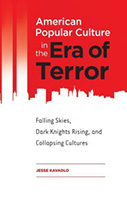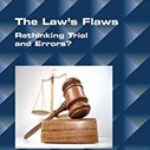American Popular Culture in the Era of Terror: Falling Skies, Dark Knights Rising, and Collapsing Cultures

Author: Jesse Kavadlo
Publisher: Santa Barbara, CA: Praeger, 2015. 218p.
Reviewer: Richard Lachmann | September 2016
September 11, Jesse Kavadlo asserts in this engaging though loosely argued book, has had a decisive influence on popular culture. In a series of chapters Kavadlo, an English professor and author of a previous book on the novelist Don DeLillo, offers incisive readings of a range of books, movies and television shows. Like the Freudians who see sex everywhere, Kavadlo sees fear of terrorism in an amazing number of works, including ones written or produced before 9/11. If something isn’t influenced by 9/11, it anticipates 9/11. A cigar is never just a cigar.
Kavadlo organizes and makes sense of a vast collection of materials by grouping works of popular culture around a series of themes. Thus, he begins with Fight Club, a novel and then a movie from the 1990s that prefigures 9/11 by showing characters (in this case white Americans) whose desires for revenge lead them to formulate plots to blow up buildings and crash planes. Of course, Oklahoma City already had occurred and for Americans who were not totally blinded by prejudice it was easy to see bombings as the method of domestic extremists as well as or instead of foreign Muslims. Yet, regardless of the identity of the terrorists, depictions before 9/11 presented terror and terrorists as marginal to American life. They are presented as a bizarre and absorbing subculture.
9/11 therefore didn’t change everything, or at least not in popular culture. Kavadlo then analyzes a set of works—films like World Trade Center and United 93 and novels, most notably DeLillo’s Falling Man and Jonathan Safran Foer’s Extremely Loud and Incredibly Close. In these films and novels, 9/11 is subordinated to depictions of everyday life. Terror exists either to disrupt daily routines or to reveal the despair and corruption in ‘normal’ America. Despite the violence and death, these works end on notes of hope, or at least entertain the possibility of recovery. Violence, while not cleansing in itself, can reveal the corruption but also the possibilities for renewal in American society.
Terrorism after 9/11 was often presented indirectly. Kavadlo examines the ever more popular zombie and vampire movies, such as theTwilight series and World War Z, plus the more artful and complex DeLillo novel Cosmopolis, which was adapted into a movie. Kavadlo is convincing that the storylines and imagery can best be understood as post-9/11 expressions of American fears of the potentially greater destruction that terrorists could inflict on the US, fears that even if not realistic were repeatedly stoked by the Bush Administration and ratings-hungry news channels year after year. Kavadlo devotes an entire chapter to the long-running television series, Lost, which he sensitively explicates as an effort to work through the traumas of 9/11 the Afghan and Iraq wars and the reality of economic decline. Lost constructs and celebrates an antediluvian, or prelapsarian vision of America, in which disaster fosters rather than undermines community. This is what Americans hoped would come from 9/11 and as the political and social reality fell even shorter of the hope, shows like Lost offered a vision of what could have been. Kavadlo aptly concludes: “both our suspense and our satisfaction comes from the characters’ ability to keep going back…even as, or precisely because, in real life, as viewers, we cannot” (p. 101).
Other works address the risk of amnesia, of our collective ability to forget or slight 9/11. Films evoke the possibility that our world is staged or the product of our delusions. The forgetting, Kavadlo reminds us, was real. Images of the twin towers were removed from coffee cans, films were taken out of circulation, and The Simpsons episode set at the World Trade Center was withdrawn for a time from syndication. Cormac McCarthy’s The Road presents an America of utter destruction, but its source is never identified and instead the novel focuses on the loss of memory about the past and of one’s own identity.
The Hunger Games is directed at a young adult audience, most of whom are too young to have any memory of 9/11. However, they have grown up in a society crippled by waves of fear over old and new enemies, real and imagined. This creates an audience open to the bleak society depicted in those novels and films but also to the hopeful element contributed by the heroine’s bravery and moral standards. Kavadlo offers a nice contrast between The Hunger Games of the 2000s and the Harry Potter novels of the 1990s, written in a more hopeful time and (a point Kavadlo ignores) in a society that is less brutally competitive and which enjoys a far more vibrant safety net and much lower rate of childhood poverty.
The limited bases of Kavadlo’s comparison of The Hunger Games and Harry Potter exemplifies the strengths and limitations of his book. We are offered sophisticated and sensitive literary analyses of a seemingly unending series of books, films and TV shows. Each one reveals aspects of these cultural creations that many readers would not have noticed on their own. However, taken as a whole, the book seems overwhelmed by overkill. Adding yet more books and films to the analysis doesn’t reveal new conceptual insights. At the end, it is easy to come away from Kavadlo’s book with the sense that one can find the influence of 9/11 in almost anything written or filmed since that day, and that one can find premonitions of 9/11 in much that was produced before that date.
The brief, 5-page concluding chapter is of no help in pulling the textual analyses together. There is no effort to engage with other authors who analyze terrorism and America’s various responses to it. As a sociologist I was highly disappointed in this book. I got some enjoyable insights into books and films but was unable to take anything away that would help me make sense of 9/11 or of the politics that continue to swirl around that event and at the now decade and a half sequence of responses to that act and to the attacks and counterattacks launched by and against the US.
Richard Lachmann, Professor of Sociology, University at Albany, SUNY


